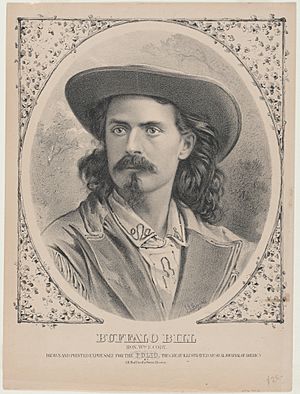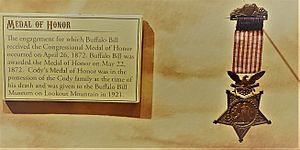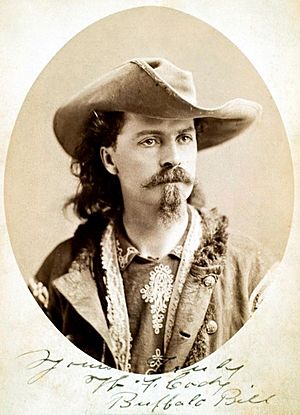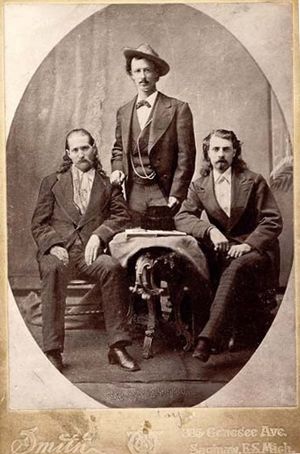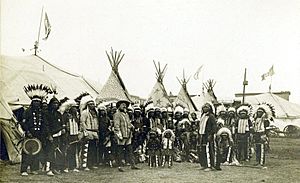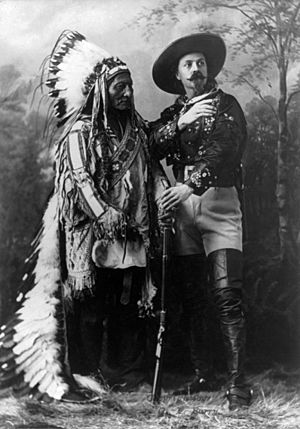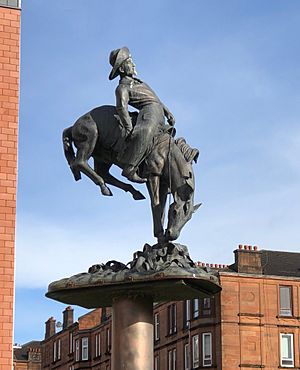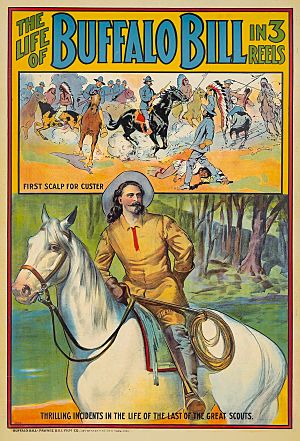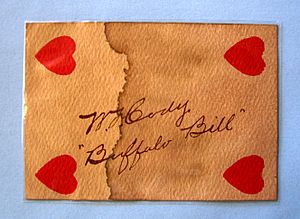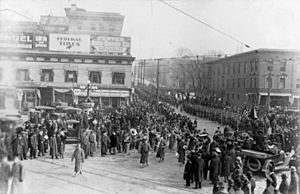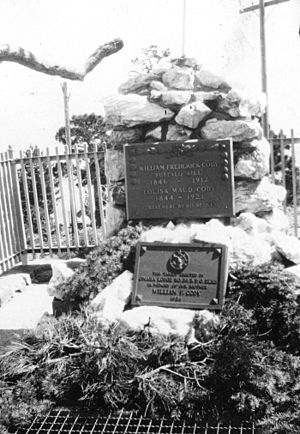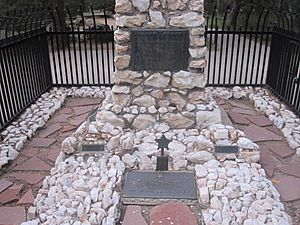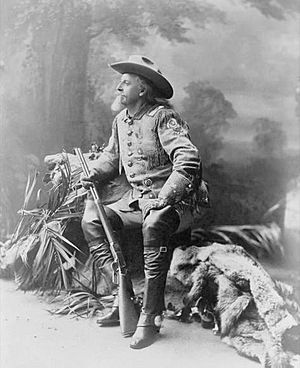Buffalo Bill facts for kids
Quick facts for kids
Buffalo Bill
|
|
|---|---|
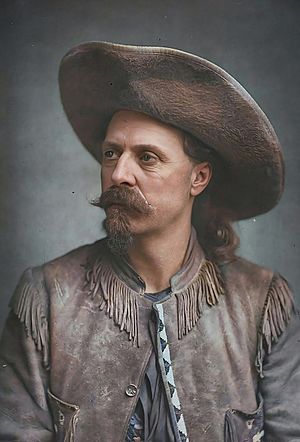
Buffalo Bill in 1911
|
|
| Born |
William Frederick Cody
February 26, 1846 Le Claire, Iowa Territory, U.S.
|
| Died | January 10, 1917 (aged 70) Denver, Colorado, U.S.
|
| Resting place | Lookout Mountain, Colorado |
| Other names | Buffalo Bill Cody Pahaska (Long hair) |
| Occupation | Army scout, Pony Express rider, ranch hand, wagon train driver, town developer, railroad contractor, bison hunter, fur trapper, gold prospector, showman |
| Known for | Buffalo Bill's Wild West shows |
| Spouse(s) | |
| Children | 4 |
| Military career | |
| Service/ |
|
| Years of service | 1863–1865, 1868–1872 |
| Rank | Private 2 (Chief of Scouts) |
| Unit | 7th Kansas Cavalry Regiment (Company H) |
| Battles/wars | American Civil War, Indian Wars (16 battles total) |
| Awards | Medal of Honor |
| Signature | |
 |
|
William Frederick Cody (February 26, 1846 – January 10, 1917), known as "Buffalo Bill", was an American soldier, bison hunter, and showman. He was born in Le Claire, Iowa Territory (now the U.S. state of Iowa), but he lived for several years in his father's hometown in modern-day Mississauga, Ontario, Canada, before the family returned to the Midwest and settled in the Kansas Territory.
Buffalo Bill started working at the age of eleven, after his father's death, and became a rider for the Pony Express at age 15. During the American Civil War, he served the Union from 1863 to the end of the war in 1865. Later he served as a civilian scout for the U.S. Army during the Indian Wars, receiving the Medal of Honor in 1872.
One of the most famous and well-known figures of the American Old West, Buffalo Bill's legend began to spread when he was only 23. Shortly thereafter he started performing in shows that displayed cowboy themes and episodes from the frontier and Indian Wars. He founded Buffalo Bill's Wild West in 1883, taking his large company on tours in the United States and, beginning in 1887, in Great Britain and continental Europe.
Contents
Early life and education
Cody was born on February 26, 1846, on a farm just outside Le Claire, Iowa. His father, Isaac Cody, was born on September 5, 1811, in Toronto Township, Upper Canada, now part of Mississauga, Ontario, directly west of Toronto. Mary Ann Bonsell Laycock, Bill's mother, was born about 1817 in Trenton, New Jersey. She moved to Cincinnati to teach school, and there she met and married Isaac. She was a descendant of Josiah Bunting, a Quaker who had settled in Pennsylvania. There is no evidence to indicate Buffalo Bill was raised as a Quaker. In 1847 the couple moved to Ontario, having their son baptized in 1847, as William Cody, at the Dixie Union Chapel in Peel County (present-day Peel Region, of which Mississauga is a part), not far from the farm of his father's family. The chapel was built with Cody money, and the land was donated by Philip Cody of Toronto Township. They lived in Ontario for several years.
In 1853, Isaac Cody sold his land in rural Scott County, Iowa, for $2000 (around $68,000 in today's money) and the family moved to Fort Leavenworth, Kansas Territory. In the years before the Civil War, Kansas was overtaken by political and physical conflict over the slavery question. Isaac Cody was against slavery. He was invited to speak at Rively's store, a local trading post where pro-slavery men often held meetings. His antislavery speech so angered the crowd that they threatened to kill him if he did not step down. A man jumped up and stabbed him twice with a Bowie knife. Rively, the store's owner, rushed Cody to get treatment, but he never fully recovered from his injuries.
In Kansas, the family was frequently persecuted by pro-slavery supporters. Cody's father spent time away from home for his safety. His enemies learned of a planned visit to his family and plotted to kill him on the way. Bill, despite his youth and being ill at the time, rode thirty miles (48 km) to warn his father. Isaac Cody went to Cleveland, Ohio, to organize a group of thirty families to bring back to Kansas, to add to the antislavery population. During his return trip, he caught a respiratory infection which, compounded by the lingering effects of his stabbing and complications from kidney disease, led to his death in April 1857.
After his death, the family suffered financially. At age 11, Bill took a job with a freight carrier as a "boy extra". On horseback he would ride up and down the length of a wagon train and deliver messages between the drivers and workmen. Next, he joined Johnston's Army as an unofficial member of the scouts assigned to guide the United States Army to Utah, to put down a rumored rebellion by the Mormon population of Salt Lake City.
According to Cody's account in Buffalo Bill's Own Story, the Utah War was where he began his career as an "Indian fighter".
At the age of 14, in 1860, Cody was caught up in the "gold fever", with news of gold at Fort Colville and the Holcomb Valley Gold Rush in California. On his way to the goldfields, however, he met an agent for the Pony Express. He signed with them, and after building several stations and corrals, Cody was given a job as a rider. He worked at this until he was called home to his sick mother's bedside.
Cody claimed to have had many jobs, including trapper, bullwhacker, "Fifty-Niner" in Colorado, Pony Express rider in 1860, wagonmaster, stagecoach driver, and a hotel manager, but historians have had difficulty documenting them. He may have fabricated some for publicity. Namely, it is argued that in contrast to Cody's claims, he never rode for the Pony Express, but as a boy, he did work for its parent company, the transport firm of Russell, Majors, and Waddell. In contrast to the adventurous rides, hundreds of miles long, that he recounted in the press, his real job was to carry messages on horseback from the firm's office in Leavenworth to the telegraph station three miles away.
Military services
After his mother recovered, Cody wanted to enlist as a soldier in the Union Army during the American Civil War but was refused because of his young age. He began working with a freight caravan that delivered supplies to Fort Laramie in present-day Wyoming. In 1863, at age 17, he enlisted as a teamster with the rank of private in Company H, 7th Kansas Cavalry, and served until discharged in 1865.
The next year, Cody married Louisa Frederici. They had four children. Two died young, while the family was living in Rochester, New York. They and a third child are buried in Mount Hope Cemetery, in Rochester.
In 1866, he reunited with his old friend Wild Bill Hickok in Junction City, Kansas, then serving as a scout. Cody enlisted as a scout himself at Fort Ellsworth and scouted between there and Fort Fletcher (later renamed and moved to Fort Hays). He was attached as a scout, variously, to Captain George Augustus Armes (Battle of the Saline River) and Lieutenant Colonel George Armstrong Custer (guide and impromptu horse race to Fort Larned). It was during this service at Fort Ellsworth that he met William Rose, with whom he would found the short-lived settlement of Rome.
In 1867, with the construction of the Kansas Pacific Railway completing through Hays City and Rome, Cody was granted a leave of absence to hunt buffalo to supply railroad construction workers with meat. This endeavor continued into 1868, which saw his hunting contest with William Comstock.
Cody returned to Army service in 1868. From his post in Fort Larned, he performed an exceptional feat of riding as a lone dispatch courier from Fort Larned to Fort Zarah (escaping brief capture), Fort Zarah to Fort Hays, Fort Hays to Fort Dodge, Fort Dodge to Fort Larned, and, finally, Fort Larned to Fort Hays, a total of 350 miles in 58 hours through hostile territory, covering the last 35 miles on foot. In response, General Philip Sheridan assigned him Chief of Scouts for the 5th Cavalry Regiment.
He was also Chief of Scouts for the Third Cavalry in later campaigns of the Plains Wars.
In January 1872, Cody was a scout for the highly publicized hunting expedition of the Grand Duke Alexei Alexandrovich of Russia.
Medal of Honor
Cody was awarded the Medal of Honor in 1872 for documented gallantry above and beyond the call of duty as an Army scout in the Indian Wars. It was revoked in 1917, along with medals of 910 other recipients dating back to the Revolutionary War, when Congress decided to create a hierarchy of medals, designating the "Medal of Honor" as the highest military honor it could bestow. Subsequent regulations authorized the War Department to revoke prior Medal of Honor awards it considered not meeting requirements since the introduction of strict regulations promulgated under the 1917 law. Those regulations required the medal to be awarded for acts of bravery above and beyond the call of duty by officers or enlisted soldiers. Ironically, the law was enacted days before Buffalo Bill died, so he never knew a law might rescind the medal awarded to him. All civilian scout medals were rescinded since they did not appear to meet the basic criterion of being officers or enlisted soldiers, which had been expressly listed in every authorizing statute ever enacted for the Medal of Honor. Cody was one of five scouts affected. Their medals were stripped shortly after Cody died in 1917.
Cody's relatives objected, and, for over 72 years, they wrote repeatedly to the US Congress seeking reconsideration. All efforts failed, until a 1988 letter to the Senate from Cody's grandson received by the office of senator Alan K. Simpson of Wyoming, when a newly minted legislative assistant (K. Yale) took up the cause in 1989. The legal brief he drafted and submitted to the Department of Defense on behalf of the relatives of Buffalo Bill argued that civilian scouts were technically officers, as their native American counterparts were nominally scouts. However, they were given the rank and pay of officers – both for retention purposes. Also, scouts were the equivalent of "reconnaissance" for the military and thus provided highly valued services. In addition, a practical reason was to avoid mistaking them for opponents in skirmishes. Moreover, although civilian scouts might have normally been officers because of their highly valued skills, the military drawdown and related budget cuts after the Civil War left no billets available for the civilian scouts to fill, and thus they were relegated to a highly qualified status that treated them as valuable military assets without the designation or retirement benefits of officers. Nevertheless, they were treated as high-ranking military officials and had status of officers alongside their native American brethren. The brief argued for retroactive restoration of the Medal of Honor to Buffalo Bill, and the Department of Defense required the appeal to be adjudicated by the Army Board for Correction of Military Records. After months of deliberation, the Board agreed with the persuasive legal brief and made the decision to restore the Medal of Honor, not only to Buffalo Bill but also several other civilian scouts whose medals had also been rescinded.
Nickname
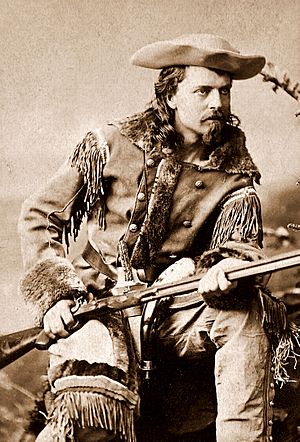
Cody received the nickname "Buffalo Bill" after the American Civil War, when he had a contract to supply Kansas Pacific Railroad workers with buffalo (American bison) meat. Cody is purported to have killed 4,282 buffalo in eighteen months in 1867 and 1868. Cody and another hunter, Bill Comstock, competed in an eight-hour buffalo-shooting match over the exclusive right to use the name, which Cody won by killing 68 animals to Comstock's 48.
Birth of the legend
In 1869, the 23-year-old Cody met Ned Buntline, who later published a story based on Cody's adventures (largely invented by the writer) in Street and Smith's New York Weekly and then published a highly successful novel, Buffalo Bill, King of the Bordermen, which was first serialized on the front page of the Chicago Tribune, beginning that December 15. Many other sequels followed by Buntline, Prentiss Ingraham and others from the 1870s through the early part of the twentieth century. Cody later became world-famous for Buffalo Bill's Wild West, a touring show which traveled around the United States, Great Britain, and Continental Europe. Audiences were enthusiastic about seeing a piece of the American West. Emilio Salgari, a noted Italian writer of adventure stories, met Buffalo Bill when he came to Italy and saw his show; Salgari later featured Cody as a hero in some of his novels.
Buffalo Bill's Wild West
In December 1872, Cody traveled to Chicago to make his stage debut with his friend Texas Jack Omohundro in The Scouts of the Prairie, one of the original Wild West shows produced by Ned Buntline. The effort was panned by critics – one critic compared Cody's acting to a "diffident schoolboy" – but the handsome performer was a hit with the sold-out crowds.
In 1873, Cody invited "Wild Bill" Hickok to join the group in a new play called Scouts of the Plains. Hickok did not enjoy acting and often hid behind scenery; in one show, he shot at the spotlight when it focused on him. He was therefore released from the group after a few months. Cody founded the Buffalo Bill Combination in 1874, in which he performed for part of the year while scouting on the prairies the rest of the year. The troupe toured for ten years.
In 1883, in the area of North Platte, Nebraska, Cody founded Buffalo Bill's Wild West, a circus-like attraction that toured annually. (Contrary to the popular misconception, the word Show was not a part of the title.) With his show, Cody traveled throughout the United States and Europe, and made many contacts. He stayed, for example, in Garden City, Kansas, in the presidential suite of the former Windsor Hotel. He was befriended by the mayor and state representative, a frontier scout, rancher, and hunter named Charles "Buffalo" Jones. In 1886, Cody and Nate Salsbury, his theatrical manager, entered into partnership with Evelyn Booth (1860–1901), a big-game hunter and scion of the aristocratic Booth family. It was at this time Buffalo Bill's Cowboy Band was organized. The band was directed by William Sweeney, a cornet player who served as leader of the Cowboy Band from 1883 until 1913. Sweeney handled all of the musical arrangements and wrote a majority of the music performed by the Cowboy Band.
In 1893, Cody changed the title to Buffalo Bill's Wild West and Congress of Rough Riders of the World. The show began with a parade on horseback, with participants from horse-culture groups that included the US and another military, cowboys, American Indians, and performers from all over the world in their best attire. Turks, gauchos, Arabs, Mongols and Georgians displayed their distinctive horses and colorful costumes. Visitors would see main events, feats of skill, staged races, and sideshows. Many historical western figures participated in the show. For example, Sitting Bull appeared with a band of 20 of his braves.
Cody's headline performers were well-known in their own right. Annie Oakley and her husband, Frank Butler, were sharpshooters, together with the likes of Gabriel Dumont and Lillian Smith. Performers re-enacted the riding of the Pony Express, Indian attacks on wagon trains, and stagecoach robberies. The show was said to end with a re-enactment of Custer's Last Stand, in which Cody portrayed General Custer, but this is more legend than fact. The finale was typically a portrayal of an Indian attack on a settler's cabin. Cody would ride in with an entourage of cowboys to defend a settler and his family. This finale was featured predominantly as early as 1886 but was not performed after 1907; it was used in 23 of 33 tours. Another celebrity appearing on the show was Calamity Jane, as a storyteller as of 1893. The show influenced many 20th-century portrayals of the West in cinema and literature.
With his profits, Cody purchased a 4,000-acre (16-km²) ranch near North Platte, Nebraska, in 1886. The Scout's Rest Ranch included an eighteen-room mansion and a large barn for winter storage of the show's livestock.
In 1887, invited by the British businessman John Robinson Whitley, Cody took the show to Great Britain in celebration of the Jubilee year of Queen Victoria, who attended a performance. It played in London and then in Birmingham and Salford, near Manchester, where it stayed for five months.
In 1889, the show toured Europe, and, in 1890, Cody met Pope Leo XIII. On March 8, 1890, a competition took place. Buffalo Bill had met some Italian butteri (a less-well-known sort of Italian equivalent of cowboys) and said his men were more skilled at roping calves and performing other similar actions. A group of Buffalo Bill's men challenged nine butteri, led by Augusto Imperiali, at Prati di Castello neighbourhood in Rome. The butteri easily won the competition. Augusto Imperiali became a local hero after the event: a street and a monument were dedicated to him in his hometown, Cisterna di Latina, and he was featured as the hero in a series of comic strips in the 1920s and 1930s.
Cody set up an independent exhibition near the Chicago World's Fair of 1893, which greatly contributed to his popularity in the United States. It vexed the promoters of the fair, who had rejected his request to participate.
In 1894, Edison Studios invited Buffalo Bill and his show to be filmed in an early silent film: Buffalo Bill.
In 1908, Pawnee Bill and Buffalo Bill joined forces and created the Two Bills show. That show was foreclosed on when it was playing in Denver, Colorado.
The Buffalo Bill and Pawnee Bill Film Company, based in New York City, produced a three-reel motion picture in 1912 titled The Life of Buffalo Bill. Cody himself appears in scenes that bookend the short film, a series of adventures presented in flashback as Buffalo Bill's dreams. The film had two other directors before it was successfully completed by John B. O'Brien. The film is in the collection of the Library of Congress.
Life in Cody, Wyoming
In 1895, Cody was instrumental in the founding of the town of Cody, the seat of Park County, in northwestern Wyoming. Today the Old Trail Town museum is at the center of the community and commemorates the traditions of Western life. Cody first passed through the region in the 1870s. He was so impressed by the development possibilities from irrigation, rich soil, grand scenery, hunting, and proximity to Yellowstone Park that he returned in the mid-1890s to start a town. Streets in the town were named after his associates: Beck, Alger, Rumsey, Bleistein, and Salsbury. The town was incorporated in 1901.
In November 1902, Cody opened the Irma Hotel, named after his daughter. He envisioned a growing number of tourists coming to Cody on the recently opened Burlington rail line. He expected that they would proceed up Cody Road, along the north fork of the Shoshone River, to visit Yellowstone Park. To accommodate travelers, Cody completed the construction of the Wapiti Inn and Pahaska Tepee in 1905 along Cody Road with the assistance of the artist and rancher Abraham Archibald Anderson.
Cody established the TE Ranch, located on the south fork of the Shoshone River about thirty-five miles from Cody. When he acquired the TE property, he stocked it with cattle sent from Nebraska and South Dakota. The new herd carried the TE brand. The late 1890s were relatively prosperous years for the Wild West show, and he bought more land to add to the ranch. He eventually held about eight thousand acres (12+1⁄2 square miles; 32 square kilometers) of private land for grazing operations and ran about a thousand head of cattle. He operated a dude ranch, pack-horse camping trips, and big-game hunting business at and from the TE Ranch. In his spacious ranch house, he entertained notable guests from Europe and America.
Cody founded the local newspaper, The Cody Enterprise, in 1899 with Col. John Peake.
Cody published his autobiography, The Life and Adventures of Buffalo Bill, in 1879. Another autobiography, The Great West That Was: "Buffalo Bill's" Life Story, was serialized in Hearst's International Magazine from August 1916 to July 1917. and ghostwritten by James J. Montague. It contained several errors, in part because it was completed after Cody's death in January 1917.
Bill's Daughter, Irma Cody, died in Cody in 1918. She is buried at Riverside Cemetery in Cody, Wyoming.
Irrigation
Larry McMurtry, along with historians such as R. L. Wilson, asserted that at the turn of the 20th century, Cody was the most recognizable celebrity on Earth. While Cody's show brought an appreciation for the Western and American Indian cultures, he saw the American West change dramatically during his life. Bison herds, which had once numbered in the millions, were threatened with extinction. Railroads crossed the plains, barbed wire, and other types of fences divided the land for farmers and ranchers, and the once-threatening Indian tribes were confined to reservations. Wyoming's coal, oil and natural gas were beginning to be exploited toward the end of his life.
The Shoshone River was dammed for hydroelectric power and irrigation. In 1897 and 1899, Cody and his associates acquired from the State of Wyoming the right to take water from the Shoshone River to irrigate about 169,000 acres (680 km2) of land in the Big Horn Basin. They began developing a canal to carry water diverted from the river, but their plans did not include a water storage reservoir. Cody and his associates were unable to raise sufficient capital to complete their plan. Early in 1903, they joined with the Wyoming Board of Land Commissioners in urging the federal government to step in and help with irrigation in the valley.
The Shoshone Project became one of the first federal water development projects undertaken by the newly formed Reclamation Service, later known as the Bureau of Reclamation. After Reclamation took over the project in 1903, investigating engineers recommended constructing a dam on the Shoshone River in the canyon west of Cody. Construction of the Shoshone Dam started in 1905, a year after the Shoshone Project was authorized. When it was completed in 1910, it was the tallest dam in the world. Almost three decades after its construction, the name of the dam and reservoir was changed to Buffalo Bill Dam by an act of Congress.
Marriage
Cody married Louisa Frederici on March 6, 1866, just a few days after his twentieth birthday. The couple met when Cody had traveled to St. Louis under his command during the Civil War.
Frederici stayed home with their four children in North Platte, while he stayed outside the home, hunting, scouting, and building up his acting career in the Wild West show. As Cody began to travel more frequently and to places farther from home, the couple grew more and more distant from each other.
Cody filed for divorce in 1904, after 38 years of marriage. Cody hoped to keep the divorce quiet, to not disrupt his show or his stage persona, but Frederici had other ideas.
Filing for divorce was scandalous in the early 20th century when marital unions were seen as binding for life. This furthered Cody's determination to get Frederici to agree to a "quiet legal separation," to avoid "war and publicity." The court records and depositions that were kept with the court case threatened to ruin Cody's respectability and credibility. His private life had not been open to the public before, and the application for divorce brought unwanted attention to the matter.
However, after the trial moved to court in February 1905, Cody changed his mind. Cody's change of mind was not due to any improvement in his relationship with Frederici but rather was due to the death of their daughter, Arta Louise, in 1904 from "organic trouble." With this weighing heavily on him, Cody sent a telegram to Frederici hoping to put aside "personal differences" for the funeral. Frederici was furious and refused any temporary reconciliation. When the trial proceeded a year later, in 1905, both their tempers were still hot. The final ruling was that "incompatibility was not grounds for divorce," so that the couple was to stay legally married. Cody returned to Paris to continue with the Wild West show and attempted to maintain a hospitable, but distant, relationship with his wife. The two reconciled in 1910, after which Frederici often traveled with her husband until he died in 1917.
Death
Cody died on January 10, 1917. He was baptized in the Catholic Church the day before his death by Father Christopher Walsh of the Cathedral Basilica of the Immaculate Conception. He received a full Masonic funeral. Upon the news of Cody's death, tributes were made by King George V, Kaiser Wilhelm II, and President Woodrow Wilson. His funeral service was held at the Elks Lodge Hall in Denver. The governor of Wyoming, John B. Kendrick, a friend of Cody, led the funeral procession to the cemetery.
At the time of his death, Cody's once-great fortune had dwindled to less than $100,000 (approximately $2,284,200 in April 2025). He left his burial arrangements with his wife. She said that he had always said he wanted to be buried on Lookout Mountain, which was corroborated by their daughter Irma, Cody's sisters, and family friends. But other family members joined the people of Cody in saying that he should be buried in the town he founded.
On June 3, 1917, Cody was buried on Lookout Mountain, in Golden, Colorado, west of Denver, on the edge of the Rocky Mountains, overlooking the Great Plains. His burial site was selected by his sister Mary Decker. In 1948, the Cody chapter of the American Legion offered a $10,000 reward (approximately $121,800 in 2025) to anyone who could steal Cody's body and deliver it to Cody, Wyoming. In response, the Denver chapter of the American Legion mounted a guard over the grave. There are still rumors about the true burial place of Buffalo Bill Cody. Although Lookout Mountain has a gravesite behind a fence and under concrete, there are claims that Cody, Wyoming was the beneficiary of a body swap carried out before he was buried in Colorado and that he was instead laid to rest on top of Cedar Mountain in Cody.
On June 9, 1917, his show was sold to Archer Banker of Salina, Kansas, for $105,000 (approximately $2,398,360 today).
Philosophy
As a frontier scout, Cody respected Native Americans and supported their civil rights. He employed many Native Americans, as he thought his show offered them good pay with a chance to improve their lives. He described them as "the former foe, present friend, the American" and once said that "every Indian outbreak that I have ever known has resulted from broken promises and broken treaties by the government."
Cody supported the rights of women. He said, "What we want to do is give women, even more, liberty than they have. Let them do any kind of work they see fit, and if they do it as well as men, give them the same pay." Women such as Annie Oakley and Calamity Jane had legendary roles in his show, and later in life Cody continued to hire and treat women fairly. Cody said in an interview in 1898, "Set that down in great big black type that Buffalo Bill favors woman suffrage… These fellows who prate about the women taking their places make me laugh… If a woman can do the same work that a man can do and do it just as well, she should have the same pay."
In his shows, the Indians were usually depicted attacking stagecoaches and wagon trains and were driven off by cowboys and soldiers. Many family members traveled with the men; Cody encouraged the wives and children of his Native American performers, as part of the show, to set up camp just as they would in their homelands. He wanted the paying public to see the human side of the "fierce warriors".
Cody was known as a conservationist who spoke out against hide-hunting and advocated the establishment of a hunting season.
Cody as a Freemason
Cody was active in the concordant bodies of the fraternal organization of Freemasonry having been initiated in Platte Valley Lodge No. 32, in North Platte, Nebraska, on March 5, 1870. He received his second and third degrees on April 2, 1870, and January 10, 1871, respectively. He became a Knight Templar in 1889 and received his 32nd degree in the Scottish Rite of Freemasonry in 1894.
Legacy and honors
- In 1872, Cody was awarded the Medal of Honor for service as a civilian scout to the 3rd Cavalry Regiment, for "gallantry in action" at Loupe Forke, Platte River, Nebraska. In 1917, after Congress revised the standards for the award, the U.S. Army removed from the rolls 911 medals previously awarded to civilians or for actions that would not warrant a Medal of Honor under the new higher standards. Cody's medal was among those revoked. In 1977, Congress began reviewing numerous cases; it reinstated the medals for Cody and four other civilian scouts on June 12, 1989.
- The Buffalo Bill Cody Scenic Byway through the Shoshone National Forest is a National Forest Scenic Byway and Wyoming Scenic Byway named after Buffalo Bill
- Because of his funding and planning with The Shoshone Project The Buffalo Bill Dam, The Buffalo Bill Reservoir created by the dam, and the Buffalo Bill State Park at the reservoir are all named after him.
- The Buffalo Bill Ranch State Park, also known as the Scout's Rest Ranch in North Platte, Nebraska was designated as a Nebraska State Historical Park in 1965, and designated a National Historic Landmark in 2021.
- Cody was honored by two U.S. postage stamps. One was a fifteen-cent Great Americans series stamp.
- The Buffalo Bill Center of the West was founded in Cody, Wyoming. The town is named in his honor.
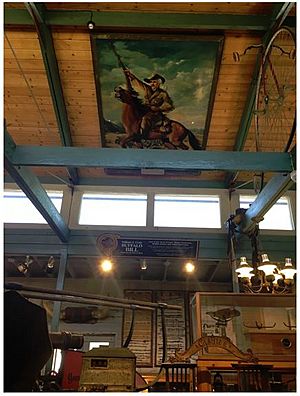
- Buffalo Bill's Wild West and the Progressive Image of American Indians is a collaborative project of the Buffalo Bill Historical Center and the history department of the University of Nebraska–Lincoln, with assistance from the Center for Digital Research in the Humanities at the University of Nebraska in Lincoln. This digital history project contains letters, official programs, newspaper reports, posters, and photographs. The project highlights the social and cultural forces that shaped how American Indians were defined, debated, contested, and controlled in this period. This project was based on the Papers of William F. Cody project of the Buffalo Bill Historical Center.
- The National Museum of American History's Photographic History Collection at the Smithsonian Institution preserves and displays Gertrude Käsebier's photographs of the Wild West show. Michelle Delaney has published Buffalo Bill's Wild West Warriors: Photographs by Gertrude Käsebier.
- Some Oglala Lakota people carry on family show business traditions from ancestors who were Carlisle Indian School alumni and worked for Buffalo Bill and other Wild West shows. Several national projects celebrate Wild Westers and Wild Westing. Wild Westers still perform in movies, powwows, pageants, and rodeos.
- The Buffalo Bills, a National Football League team based in Buffalo, New York, were named after the entertainer. Other early football teams (such as the Buffalo Bills of the All-America Football Conference) used the nickname, solely for name recognition, as Cody had no special connection with the city of Buffalo. He did however live for a few years in nearby Rochester. Three of Buffalo Bill's children are buried at Mount Hope Cemetery in Rochester, New York.
- Euro Disneyland Railroad locomotive #1 is named the W. F. Cody in his honor.
- In 1958, he was inducted into the Hall of Great Westerners of the National Cowboy & Western Heritage Museum.
- Bubble O' Bill, an ice cream in the shape of a cowboy currently sold in Australia and previously available in the United States and United Kingdom, is named as such after Cody's stage name.
Statues
- "The Scout" 1924, by Gertrude Vanderbilt Whitney, in Cody, Wy
- "Buffalo Bill – Plainsman" 1976, by Bob Scriver, in Cody, Wy
- "The Spirit of Cody" 1999 by Jeffery B. Rudolph in Cody, Wy
- "Born Under a Wandering Star" by Vic Payne in Cody, Wy
- "Howdy Folks" 2000, by Jeffery Rudolph in Golden, Colorado
- "Buffalo Bill Monument" 2004 by Charlie Norton in Oakley, Kansas
- "Buffalo Bill " at the National Cowboy & Western Heritage Museum in Oklahoma City
- "Buffalo Bill Statue" 2006 in Glasgow
- "America" 1876 by John Bell (sculptor), a section of the Albert Memorial in Hyde Park, London features a western figure that bears a resemblance to Buffalo Bill standing next to an American Bison.
See also
 In Spanish: Buffalo Bill para niños
In Spanish: Buffalo Bill para niños
- Buffalo Bill Cody Homestead
- Bungalow Bill
- List of Medal of Honor recipients for the Indian Wars
- Ned Buntline
- Pony Express
- Show Indians
- Wild Westing
- William "Doc" Carver
- William Sloan Tough


